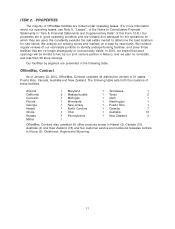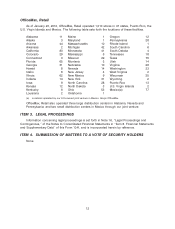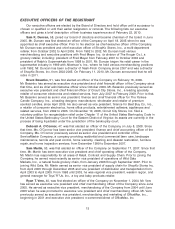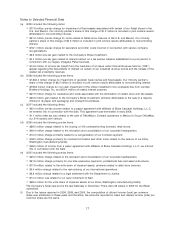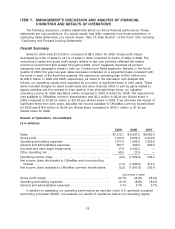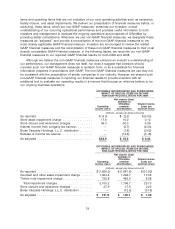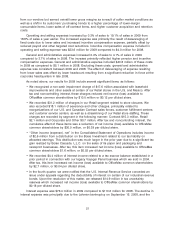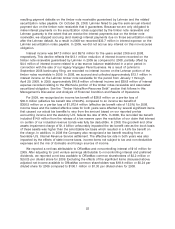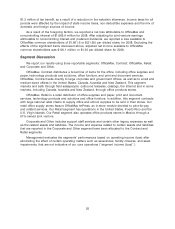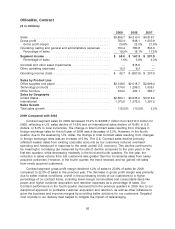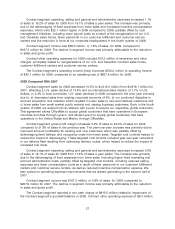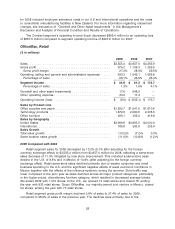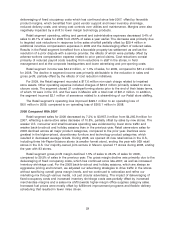OfficeMax 2009 Annual Report Download - page 24
Download and view the complete annual report
Please find page 24 of the 2009 OfficeMax annual report below. You can navigate through the pages in the report by either clicking on the pages listed below, or by using the keyword search tool below to find specific information within the annual report.These items are described in more detail in this Management’s Discussion and Analysis.
At the end of the 2009 fiscal year, we had $486.6 million in cash and cash equivalents and
$513.0 million in available (unused) borrowing capacity under our revolving credit facilities. The
combination of cash and cash equivalents and available borrowing capacity yields approximately
$1 billion of overall liquidity. The Company has strengthened its balance sheet, cash position and
liquidity greatly during 2009. At year-end, we had outstanding recourse debt of $297.1 million (both
current and long-term) and non-recourse obligations of $1,470.0 million related to the timber
securitization notes. There is no recourse against OfficeMax on the securitized timber notes payable
as recourse is limited to proceeds from the applicable pledged installment notes receivable and
underlying guarantees. There were no borrowings on our revolving credit facilities in 2009.
The funded status of our pension plans also improved in 2009. Our pension obligations
exceeded the assets held in trust to fund them by $210.2 million at year-end 2009, a decrease of
$224.8 million compared to the $435.0 million under funding that existed at year-end 2008. This
reduction was due to strong returns on plan investments in the year coupled with our voluntary
excess contribution of 8.3 million shares of OfficeMax common stock to the plans in the fourth
quarter of 2009.
For the full year 2009, we generated $358.9 million of cash from operations reflecting our focus
on cash generation. Working capital improved $219.0 million as a result of significant management
oversight, which yielded reduced days outstanding for accounts receivable and a decrease in
inventory per location along with an improved accounts payable leverage ratio. We also collected
$71.0 million of tax refunds, net of payments, and borrowed $45.7 million on accumulated earnings
held in company-owned life insurance policies. In addition, we received $41.1 million from
investment activities, including $25.1 million from a prior tax escrow settlement and $15.0 million in
additional company-owned life insurance withdrawals.
Outlook
Given the continued weak economic environment, we are cautious in our expectations for
2010. We expect that U.S. unemployment trends will continue to unfavorably impact us in the
near-term, with improvement occurring in the later part of the year. We anticipate that for the full
year 2010, total sales, including the impact of foreign currency translation, and adjusted operating
income margin will be slightly higher than they were in 2009. We expect positive cash flow from
operations, although lower than 2009, due to a larger-than-expected incentive compensation payout
during the first quarter and higher working capital needs due to the increased sales. We also
believe that our liquidity position will remain strong and our need to access our revolving line of
credit will be limited to seasonal periods.
2009 Compared with 2008
Sales for 2009 decreased 12.8% to $7,212.1 million from $8,267.0 million for 2008. The
year-over-year sales decreases occurred in both our Contract and Retail segments and resulted
primarily from the weaker economic environment that existed throughout all of 2009. The change in
sales resulting from changes in foreign exchange rates for the full year of 2009 was a decrease of
1.7%. However, in the fourth quarter, due to the weakening U.S. dollar, the change in total sales
resulting from changes in foreign exchange rates was an increase of 2.8%.
Gross profit margin decreased by 0.8% of sales to 24.1% of sales in 2009 compared to 24.9%
of sales in 2008. The gross profit margins declined in both our Contract and Retail segments. The
Retail segment experienced strong cost support from our vendors and reduced inventory shrinkage,
the benefits of which were entirely offset by deleveraging of fixed occupancy costs and a mix shift
to less profitable technology products. The Contract segment also experienced strong cost support
20



